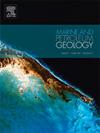δ13C signatures of a natural gas zone with high H2S content in a major unconventional petroleum accumulation, Montney Formation, western Canada
IF 3.7
2区 地球科学
Q1 GEOSCIENCES, MULTIDISCIPLINARY
引用次数: 0
Abstract
We report geochemical data from mud gas, produced gas and produced hydrocarbon liquid samples for three horizontal wells that produced hydrocarbons from the Montney unconventional petroleum accumulation in west-central Alberta. Mud gas data from the deepest well provide a rare opportunity to characterize the trends of C1-C3 δ13C values in a high-H2S (∼13 %) zone at high-resolution increments (50–100 m) along ∼1,500 m of a horizontal well. The results suggest that H2S in this zone was generated by thermochemical sulfate reduction (TSR) close to the time of maximum burial (∼60–80 Ma) and ceased during subsequent uplift. Produced gas samples from the horizontal well in the high-H2S zone have abnormally enriched ethane and propane δ13C values compared to those from other wells in the Montney unconventional play. This strong isotopic enrichment reflects oxidation of ethane and propane during TSR reactions and produces an anomalous, strongly convex-upward profile on a Chung plot. Mud gas samples from the horizontal well in the high-H2S zone have δ13C values that increase laterally from south to north by 7.5 ‰ for ethane and 5.6 ‰ for propane, while the corresponding methane δ13C values are essentially invariant. This suggests that ethane and propane were the main hydrocarbon reactants oxidized during TSR reactions, and that methane was not significantly involved. Our findings are consistent with those of previous studies on TSR-influenced gas systems in western Canada and other basins showing there is limited variation in methane δ13C values with progressive TSR until ethane and propane are wholly consumed.
加拿大西部Montney组非常规油气高硫化氢天然气带的δ13C特征
本文报告了阿尔伯塔省中西部蒙特尼非常规油气聚集的三口水平井的泥浆气、产出气和产出烃液样品的地球化学数据。来自最深井的泥浆气数据提供了一个难得的机会,可以描述高h2s(~ 13%)区域C1-C3 δ13C值的趋势,在水平井~ 1500米的高分辨率增量(50-100米)。结果表明,在最大埋藏时期(~ 60 ~ 80 Ma),该带的H2S由热化学硫酸盐还原(TSR)产生,并在随后的隆升过程中停止。与Montney非常规油气区其他井相比,高硫化氢带水平井采出气样品的乙烷和丙烷δ13C值异常丰富。这种强烈的同位素富集反映了乙烷和丙烷在TSR反应中的氧化作用,并在Chung图上产生了一个异常的、强烈的向上凸剖面。高硫化氢带水平井泥浆气样品的δ13C值自南向北增加,乙烷δ13C值增加7.5‰,丙烷δ13C值增加5.6‰,甲烷δ13C值基本不变。这说明在TSR反应中,乙烷和丙烷是主要的烃类反应物,甲烷的参与并不明显。我们的发现与之前对加拿大西部和其他盆地TSR影响的天然气系统的研究一致,表明甲烷δ13C值随着TSR的增加而变化有限,直到乙烷和丙烷完全消耗。
本文章由计算机程序翻译,如有差异,请以英文原文为准。
求助全文
约1分钟内获得全文
求助全文
来源期刊

Marine and Petroleum Geology
地学-地球科学综合
CiteScore
8.80
自引率
14.30%
发文量
475
审稿时长
63 days
期刊介绍:
Marine and Petroleum Geology is the pre-eminent international forum for the exchange of multidisciplinary concepts, interpretations and techniques for all concerned with marine and petroleum geology in industry, government and academia. Rapid bimonthly publication allows early communications of papers or short communications to the geoscience community.
Marine and Petroleum Geology is essential reading for geologists, geophysicists and explorationists in industry, government and academia working in the following areas: marine geology; basin analysis and evaluation; organic geochemistry; reserve/resource estimation; seismic stratigraphy; thermal models of basic evolution; sedimentary geology; continental margins; geophysical interpretation; structural geology/tectonics; formation evaluation techniques; well logging.
 求助内容:
求助内容: 应助结果提醒方式:
应助结果提醒方式:


